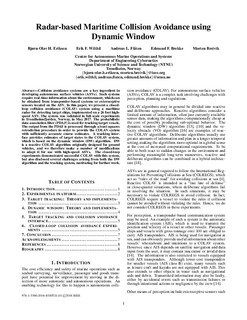Radar-based Maritime Collision Avoidance using Dynamic Window
Eriksen, Bjørn-Olav Holtung; Wilthil, Erik Falmår; Flåten, Andreas Lindahl; Brekke, Edmund Førland; Breivik, Morten
Journal article, Peer reviewed
Accepted version

Åpne
Permanent lenke
http://hdl.handle.net/11250/2592280Utgivelsesdato
2018Metadata
Vis full innførselSamlinger
Originalversjon
IEEE Aerospace Conference. Proceedings. 2018, 2018-March 1-9. 10.1109/AERO.2018.8396666Sammendrag
Collision avoidance systems are a key ingredient in developing autonomous surface vehicles (ASVs). Such systems require real-time information about the environment, which can be obtained from transponder-based systems or exteroceptive sensors located on the ASV. In this paper, we present a closed-loop collision avoidance (COLAV) system using a maritime radar for detecting target ships, implemented on a 26 foot high-speed ASV. The system was validated in full-scale experiments in Trondheimsfjorden, Norway, in May 2017. The probabilistic data association filter (PDAF) is used for tracking target vessels. The output from the PDAF is processed through a least-squares retrodiction procedure in order to provide the COLAV system with sufficiently accurate course estimates. A tracking interface provides estimates of target states to the COLAV system, which is based on the dynamic window (DW) algorithm. DW is a reactive COLAV algorithm originally designed for ground vehicles, and we therefore make a number of modifications to adapt it for use with high-speed ASVs. The closed-loop experiments demonstrated successful COLAV with this system, but also disclosed several challenges arising from both the DW algorithm and the tracking system, motivating for further work.